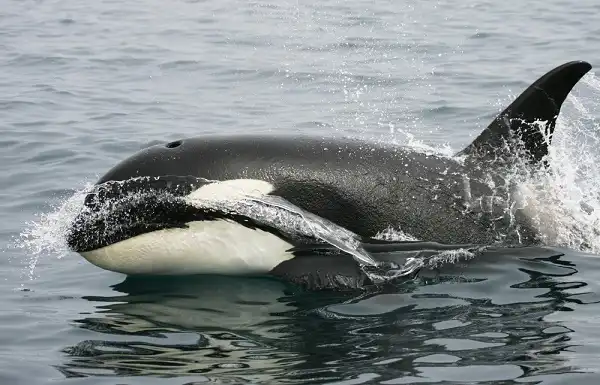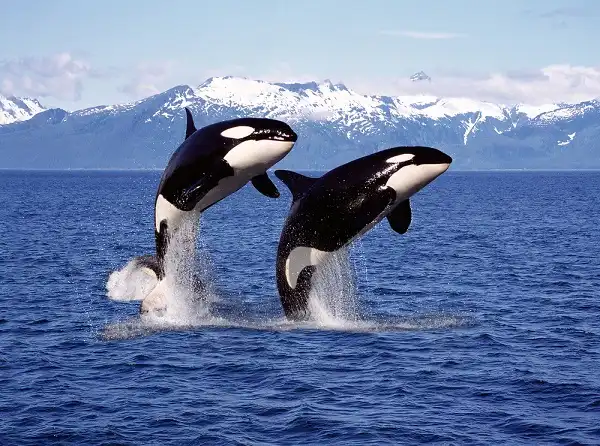Orcas, or killer whales, are one of the most widely distributed mammals on Earth. Though they’re often associated with cold water climates, orcas actually inhabit all of the world’s oceans. These intelligent and social creatures are known to form close bonds with their family and pod members, and some pods even have their own distinct dialects. Orcas are apex predators, meaning they’re at the top of the food chain, and play an important role in maintaining a healthy marine ecosystem. Here’s what you need to know about these incredible animals.

Killer Whale Description
Orcas, or killer whales, are one of the most widely distributed mammals on Earth. Their flippers are also very large and rounded, helping them to steer through the water at fast speeds of up to 35 miles per hour. Orcas also have excellent eyesight, hearing, and echolocation capabilities which help them hunt their prey with great efficiency. Killer whale pods typically consist of around 15 individuals and are extremely social creatures, often forming strong bonds with other members of their family unit. Some pods even develop distinct dialects that all the members understand. Additionally, they often feature distinctive white spots or “eye patches” on their black bodies which can help differentiate them from other species of dolphins. Another distinguishing feature is the presence of grey saddle markings just behind the dorsal fin which are usually present in mature orcas but not juveniles.
Killer Whale Habitat
Killer whales, also known as orcas, are found in all of the world’s oceans and sometimes in isolated river systems. They occupy a wide range of habitats from cold polar waters to warm tropical seas, and can even be seen close to shore or out in the open ocean. Resident pods typically remain in one area throughout their lives while transient ones will swim through large ranges over many years looking for food sources. In addition, some pods are composed entirely of males while others have both sexes present. The habitat preferences of killer whales are highly dependent on seasonality as they will often migrate long distances to take advantage of more abundant food sources during certain times of the year. These creatures also utilize echolocation to navigate through their environment with great accuracy which helps them locate prey at greater depths or farther away from them than other species may be capable of doing.
Killer Whale Diet
Killer whales, or orcas, have an incredibly varied diet that consists of a wide range of prey items depending on the species and location. For example, offshore populations primarily feed on fish while those living closer to shore hunt for seals and sea lions. They also eat sharks, squid, sea birds, and sometimes even other marine mammals like dolphins or whales! Killer whales typically consume between 140-400 pounds of food per day depending on size and sex; however, they can go without eating for several days if necessary due to their large reserves of blubber. In addition, groups have been known to share meals with one another by passing chunks of food back and forth among members which could be an indication of social bonding behavior similar to other species like chimpanzees or gorillas! The diet of killer whales varies greatly across different regions based on local availability; however, all species exhibit some level of dietary flexibility when necessary.

Killer Whale Size
Killer whales are incredibly impressive creatures, and their size certainly reflects that. On average, adult male killer whales grow to be around 20-26 feet long and can weigh up to 6 tons. Females tend to be a bit smaller, growing up to 23 feet in length and weighing up to 3-4 tons. However, some very large individuals have been known to reach lengths of over 32 feet and weigh more than 10 tons! The dorsal fin of an adult orca is typically between 6-8 feet tall with males having larger fins than females. Despite their intimidating size killer whales have few natural predators due largely in part to their swiftness in water as well as the protective nature of female pods which often cooperate together when defending against potential threats. Overall killer whales are truly amazing creatures whose incredible size both impresses us and serves them well in the wild by allowing them access to bigger prey items while providing protection from potential predators at the same time.
Killer Whale Lifespan
Killer whales have an impressive lifespan and can live up to 50-80 years depending on the individual’s species, sex, and overall health. Orcas that inhabit warmer climates tend to have shorter lives than those living in colder regions due to a higher risk of infection and disease. Similarly, females are known to outlive males as they generally receive more parental care throughout their lifespan, leading to longer life expectancy. The longest known lifespan of an orca is thought to be around 98 years, which is attributed to a female orca found in Puget Sound. This incredible individual was named ‘Granny’ by researchers and had been documented since the 1960s until her death in 2016. It is speculated that the extended lifespan could have been due to Granny’s unique diet which included mostly salmon instead of seals or other mammal prey like many other killer whales eat. Killer whales typically reach sexual maturity between 8-12 years old for females, while males may become mature at around 15-16 years old; however, this can vary greatly depending on the individual’s environment and availability of food resources. After reaching maturity they often form long-lasting bonds with other members of their pods which can last for decades if not their entire lifespans!
Killer Whale Behavior
Killer whale behavior is an incredible example of the complex social and environmental dynamics of nature. They are highly intelligent animals with a variety of complex behaviors that demonstrate their intelligence, social skills, and adaptability to their environment. Killer whales show sophisticated levels of communication among members of their pod, including vocalizations, body language, and even facial expressions. Certain sounds within the pod’s repertoire indicate a particular context or purpose such as sound calls for group coordination or alarm calls when danger is present. They even have elaborate patterns of “culture” which vary between populations in terms of food preferences, hunting strategies, and mating rituals. Overall killer whales are truly amazing creatures whose impressive behaviors provide us with an insight into the complexity and beauty of nature. Unfortunately, human activity continues to threaten this species’ habitats putting many populations at risk if steps aren’t taken soon toward conservation efforts that help protect them for future generations!

Killer Whale Speed
Killer whales are incredibly fast swimmers, able to reach speeds of up to 30 mph (48 km/h) when necessary. However, they are usually quite slow when traveling long distances and conserve their energy whenever possible. This is why they often move at an average speed of 5-10 mph (8-16 km/h) when traveling long distances, although this can vary depending on the environment and the size and shape of the pod. In addition to traveling at high speeds, killer whales also employ sophisticated strategies such as echolocation to aid in their navigation around obstacles like rocks or underwater caves. Echolocation involves emitting sound waves that bounce off objects in their environment, allowing them to detect what lies ahead and maneuver accordingly. This technique not only helps them avoid dangerous obstacles but also allows them to detect prey within close range. When hunting larger prey items like seals or dolphins, killer whales use a technique called “carousel feeding” which involves several members of the pod working together to herd their target into shallow water or onto land where they can be easily consumed by the entire group. During this type of predation, individuals may swim up to 20 mph (32 km/h) in order to keep pace with the target animal and maintain their position within the carousel formation until successful capture is achieved.
Killer Whale Hunting
Killer whales are highly sophisticated hunters who employ a variety of strategies to capture their prey. The most common hunting technique is called “carousel feeding” which involves several members of the pod working together to herd their target into shallow water or onto land where they can be easily consumed by the entire group. Along with speed, agility is also an important factor when it comes to capturing prey. Killer whales often perform impressive leaps and acrobatics out of the water in order to surprise their quarry or confuse them while they are in pursuit. They may also employ techniques such as spy hopping (vertically lifting their heads out of the water) as well as tail-slapping and lobtailing (lifting their flukes above the surface), pec slapping (slapping their pectoral fins against the water’s surface) which can create shockwaves that stun fish or other small animals making them easier to catch!

Conclusion
Killer whales are remarkable animals that possess impressive levels of speed, agility, and coordination which make them successful hunters within their changing environment. Along with carousel feeding, they employ a variety of other techniques to capture prey including echolocation, breaching, tail-slapping, pec slapping, and more! Despite these formidable skills, however, killer whale populations remain threatened by human activities such as overfishing or marine pollution. To ensure the survival of this species for generations to come it’s important that steps towards conservation be taken soon in order to protect them properly. With proper protection, we can help ensure that killer whales will continue to thrive in our oceans!
Frequently Asked Question

